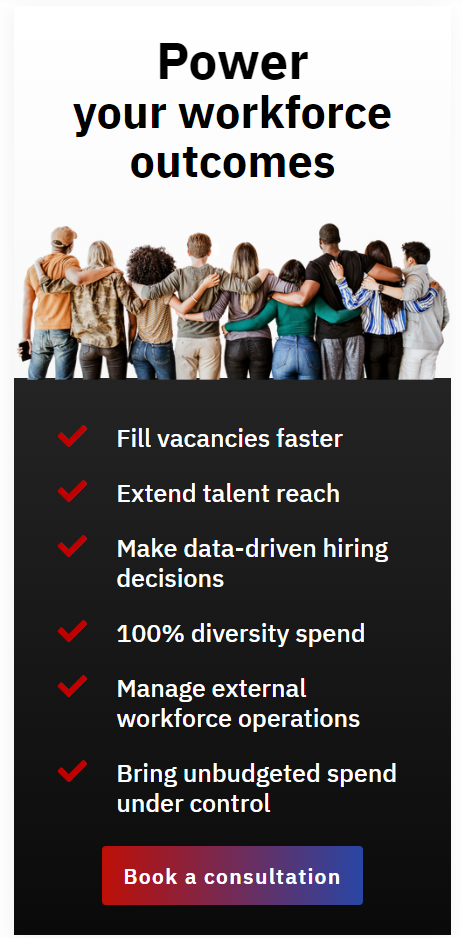Published : January 9th 2025
How to Calculate the ROI of an MSP Partnership
Many organizations feel pressured to manage contingent labor efficiently. A Managed Service Provider (MSP) can handle vendor selection, rate negotiation, compliance tracking, and performance oversight—reducing administrative burdens on internal teams. Yet leaders often struggle to gauge whether these advantages justify the costs. How can they measure the ROI of an MSP Partnership in concrete terms?
At Workspend, we focus on optimizing workforce solutions to help clients reduce overhead, improve time-to-fill, and maintain compliance across various industries. In the sections below, you’ll find key performance indicators, data collection methods, and a structured approach for evaluating both immediate and long-term results. Following these guidelines will clarify whether an MSP arrangement aligns with your financial and operational goals—and ultimately confirms the ROI of an MSP Partnership.
Understanding an MSP Partnership
An MSP oversees vital elements of a contingent workforce management program, such as vendor management, compliance oversight, talent sourcing, and performance tracking. Many also employ specialized technology or a vendor management system (VMS) to centralize these functions.
Organizations often turn to MSPs to address fragmented supplier relationships, high labor costs, and persistent compliance issues. Providing a single point of contact, standardized processes, and negotiated rates allows MSPs to minimize administrative burdens. At Workspend, our tech-enabled framework targets these challenges—laying the groundwork for understanding how the ROI of an MSP Partnership takes shape.
A 2023 study found that 80% of surveyed organizations currently employ contingent workers, and 65% anticipate increasing their reliance on these workers in the next two years. However, 70% of respondents reported moderate or significant challenges integrating contingent talent into their existing teams.
Why ROI Matters in MSP Engagements
Knowing how MSPs function is only half the story. CFOs and HR teams, often managing tight budgets, need evidence that each dollar spent yields clear benefits. Calculating the ROI of an MSP Partnership reveals whether costs decrease, operational efficiency improves, and workforce quality rises.
ROI isn’t just about cost savings. It also captures risk reduction and alignment with broader corporate objectives. Tracking these areas shows how MSP activities feed into overarching strategies. Without careful measurement, hidden expenses or inefficiencies can weaken support for the partnership over time.
Key Value Drivers in an MSP Partnership
When it comes to quantifying an MSP’s impact, several core factors drive ROI of an MSP partnership. The first is cost savings, which arise from rate negotiation and streamlined administration. MSPs use market intelligence to standardize vendor rates and minimize hidden charges, while centralized invoicing and compliance oversight prevent redundant tasks and potential errors.
Second, risk and compliance management protects organizations from legal exposure. Properly classifying workers and keeping up with shifting regulations helps avoid penalties or fines. This proactive stance ensures that labor law violations or misclassification issues do not derail broader objectives, further strengthening the ROI of an MSP partnership.
Third, operational efficiency shapes ROI through faster time-to-fill and ongoing supplier performance monitoring. Accelerating recruitment and maintaining scorecards help MSPs enhance the quality of contingent workers. Meanwhile, workforce visibility and analytics yield real-time insights on spending, compliance, and usage trends—key elements of modern workforce solutions.
Finally, scalability highlights another crucial advantage: the ability to flex staffing levels with changing business needs, a central aspect of contingent workforce management. Whether you need a quick expansion for seasonal demand or want to reduce overhead in a slower period, an MSP model adapts without the fixed costs of permanent hires. Collectively, these factors demonstrate that the ROI goes beyond simple cost reductions, encompassing risk mitigation, efficiency gains, and staffing cost optimization.
Step-by-Step Guide to Calculating ROI
A structured approach is essential for assessing the ROI of an MSP Partnership. The following steps provide a clear roadmap for gathering data, setting goals, and turning raw metrics into actionable insights:
Step 1: Establish Your Baseline
Begin by reviewing historical data, such as vendor costs, time-to-fill metrics, and compliance incidents. Pinpoint which categories—like cost per hire or turnover—carry the most weight in your organization’s budget and risk profile. This baseline acts as your reference point for progress.
Step 2: Define Clear Objectives
Next, set specific targets and tie them to relevant KPIs. Maybe you aim to lower contingent labor costs by 15% or reduce time-to-fill significantly. Clearly defining these goals ensures the MSP understands what “success” looks like from the outset.
Step 3: Quantify Tangible and Intangible Savings
Calculate direct cost reductions from negotiated vendor rates or centralized billing. Then address indirect gains, such as reduced legal exposure or more efficient management practices. These “soft” benefits can still translate to substantial returns over time.
Step 4: Monitor Performance and Adjust
ROI measurement should be ongoing. Compare current metrics to your baseline and watch for patterns in real time. If performance plateaus, renegotiate vendor terms or refine processes to maintain strong outcomes.
Step 5: Present Findings to Stakeholders
Summarize cost savings, risk mitigation, and operational efficiency gains in a concise report. This transparency supports well-informed decisions about future program expansions or strategic adjustments.
Overcoming Common Pitfalls
Even with a solid plan, certain issues can distort ROI calculations. Inconsistent data collection skews baseline comparisons, so tracking expenditures, hiring times, and compliance records accurately is crucial. Misaligned goals also cause confusion: if leadership wants quick returns while the MSP strategy unfolds more gradually, results may seem underwhelming. Regular checkpoints keep expectations realistic.
Overlooking indirect savings can lead to an incomplete ROI picture. Focusing only on immediate cost cuts ignores broader benefits like risk reduction or improved workforce quality. Finally, failing to recalibrate can let metrics go stale. Organizational changes—like expansions or acquisitions—require periodic adjustments to keep ROI targets valid and actionable.
Future Trends and Considerations
Some worry that an MSP’s fees will eat into their workforce cost savings, but a transparent pricing model reveals exactly where your money goes—and why the overall value often outweighs the costs. MSPs share regular reports on cost reductions, supplier performance, and ROI, proving the partnership justifies its price.
Even if there’s an initial outlay, the longer-term benefits—like tighter processes, reduced risks, and better talent management strategy—tend to exceed those upfront expenses. The MSP’s role is to consistently deliver value that surpasses its own fees, ensuring a net positive outcome for your organization.
Where Does Workspend Fit?
Several developments are changing how organizations measure ROI. Operational efficiency is likely to benefit from advanced analytics and AI-driven matching, which refine workforce planning and speed up hiring. Global expansions raise compliance challenges, making MSP oversight critical to avoid penalties. Meanwhile, evolving skill demands require fast access to specialized talent, highlighting the value of adaptable workforce solutions.
Conclusion and Next Steps
An MSP partnership should deliver clear, quantifiable returns that align with your organization’s goals. Tracking costs, compliance metrics, and performance benchmarks helps leadership gauge genuine impact. With the right data and strategy in place, your MSP partnership can evolve into a true driver of competitive advantage—one that fully justifies every dollar spent
If current outcomes are muddled or falling short, it may be time for a closer look. Workspend offers a discovery assessment to ensure you’re getting the most out of your MSP setup. This personalized review goes beyond straightforward cost reduction, pinpointing steps toward greater operational efficiency, stronger workforce solutions, and sustainable growth.
You may also like:
Why Building the Right MSP Business Case Is Essential for Growth
Published : April 23rd 2025Why Building the Right MSP Business Case Is Essential for Growth A Managed Service Provider (MSP) can be a game-changer when it comes to handling contingent workforce management, consolidating vendor oversight, and boosting efficiency. Yet,...
AI Should Augment Human Intelligence, Not Replace It
Will smart machines replace human workers? How human intelligence can work with artificial intelligence to produce augmented intelligence.
Common Challenges When Setting Up an MSP and How to Overcome Them
Published : March 4th 2025Common Challenges When Setting Up an MSP and How to Overcome Them Finding the right balance of full-time employees and temporary staff is a key strategic goal for many organizations facing rising demands and growing compliance pressures. As...
Power your workforce
outcomes with a diversity MSP






